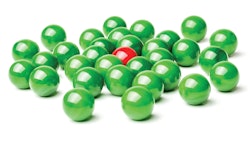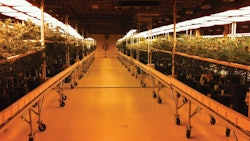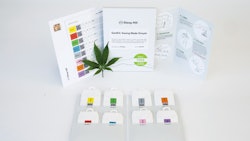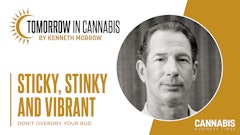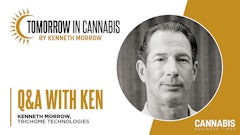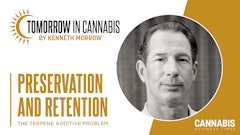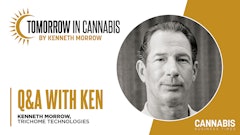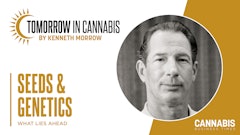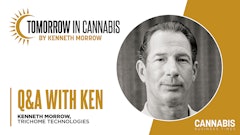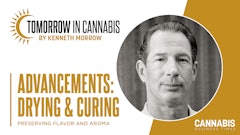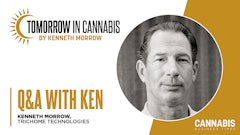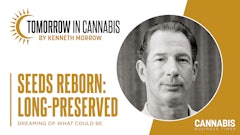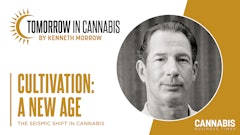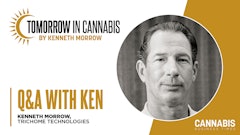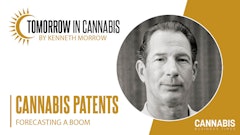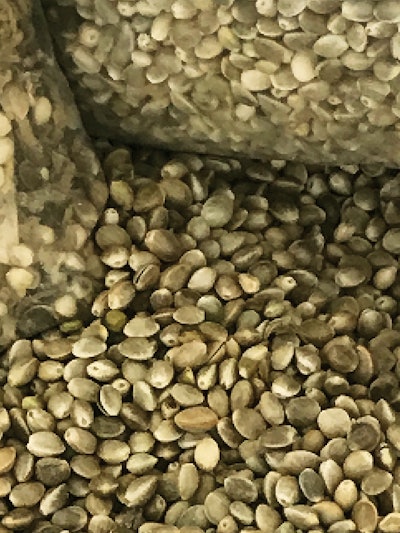 Hemp seeds from Hemp Crew Corp. in Canada. The company sells truckloads of seeds as dehulled hempseed and bird feed.
Hemp seeds from Hemp Crew Corp. in Canada. The company sells truckloads of seeds as dehulled hempseed and bird feed.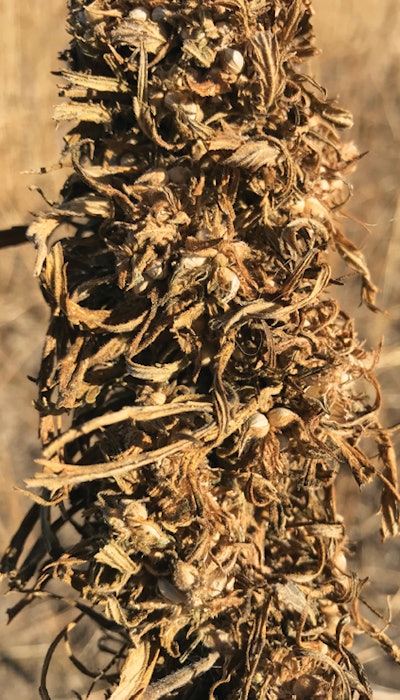 A close-up of a hemp cola. The company completes harvest in one day by removing top of the plants and leaving the unusable stalks in the ground.
A close-up of a hemp cola. The company completes harvest in one day by removing top of the plants and leaving the unusable stalks in the ground.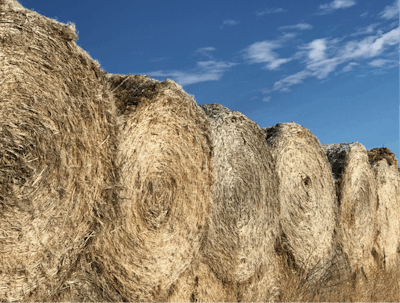 Without a market for the hemp fiber, Hemp Crew Corp. can only roll the fiber in large bales and use those as windbreakers on its property.
Without a market for the hemp fiber, Hemp Crew Corp. can only roll the fiber in large bales and use those as windbreakers on its property.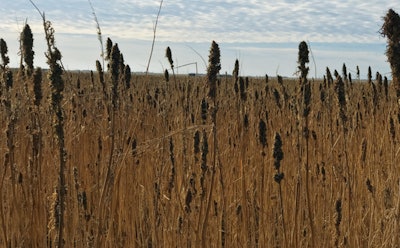 The windy and arid conditions are not conducive to large bud production. The hemp stalks at Hemp Crew Corp. usually only have one large cola at the top.
The windy and arid conditions are not conducive to large bud production. The hemp stalks at Hemp Crew Corp. usually only have one large cola at the top.Click Image to View Gallery
The first U.S. regulation of cannabis was the “Marijuana Act of 1937.” Since then, it has been illegal to grow hemp in America.The country’s dependency on and use of the plant has been minimized to the extent that hemp production almost no longer exists in American agriculture.
As Jack Herer famously said many years ago, “Hemp can save the planet.” Many people understand that hemp can help save the planet through a variety of ways, including protein, oil and fiber-use possibilities, for example. But, surprisingly, the masses are not beating down the door to purchase raw hemp fiber, despite all these uses.
While I do not believe I will ever see products like T-shirts manufactured solely out of hemp made in North America (mainly because foreign manufacturing costs are lower), that does not mean we should not be actively exploring the economic value of diversified hemp products.
Now is the time for hemp production to begin again. But this can only happen if manufacturers embrace and incorporate hemp-based products into their products, and a new industry rises to pioneer innovative processes and uses for the hemp plant and its offerings.
A Story of Today’s Hemp Farmer
Recently, I was contacted by a Canadian hemp farmer, Duane Phillippi of The Hemp Crew Corp., who requested that I visit his 1,800-acre farm during harvest season. While he was specifically interested in understanding the applications for essential oils and raw products in today’s economy, he had brought me there to evaluate current practices, and envision workflow and objectives for next year’s production.
Currently, the crop from the farm is sold as two products: seeds for dehulled hempseed and as bird feed. The corky ‘hurd’ from the stalk is utilized to manufacture paper. As of now, there are no customers to purchase the leftover fiber materials, which have been pressed into huge, round bales, then stacked and utilized for wind breaks on the farm.
The owner and his team have had to redesign and modify existing equipment to suit their specific needs. They have an engineer on staff who handles this. Plus, the equipment needed to harvest and process 1,800 acres of hemp can cost millions, and this is the company’s fourth year in operation.
The crew was already hard at work when I arrived at the farm, and large equipment was already rolling. The morning began with a group meeting where a plan for the day was set. Everybody was assigned a role and told where they could assist in other areas, keeping in mind the workday would not end till 12:30 a.m., when the last acre was harvested. After the meeting, we toured the farm so I could familiarize myself with current methods of growth, harvest and post-processing of products.
We began by examining the raw finished products, both the seed and the un-powdered hurd. It was amazing to see so many hemp seeds (literally truckloads of them) for the first time. The raw hurd is the byproduct of the hemp stalks. It still has a lot of fiber mixed in with it that will ultimately be pulverized and turned to powder, which is how the paper manufacturer requests it.
Next, we toured multiple plots—some harvested, some not. The harvested plots still had the hemp stalks remaining in rows as they grew. The unharvested plots had a single stalk plant with one bud at the top.
From there we went to see his endeavor into essential oil collection, which was amazing in that it contained experiments performed on a grand scale. He is working to have the process in place for later this year when the Canadian industrial hemp rules change to allow for the harvest and processing of hemp bud/flowers.
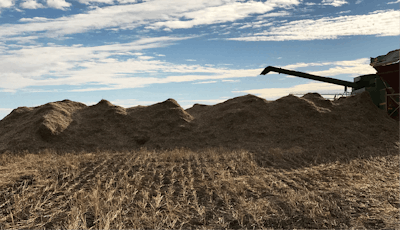
We ventured to the field next to see well over a million dollars of harvesting equipment and machinery in action. The seed was loaded into tractor trailers, then into grain silos for storage, then sent to market. The hurd is loaded into tractor trailers and hauled to the farm to be processed. In the processing area, the hurd is coarsely screened by conveyor to eliminate larger, unwanted fibrous material, and then it goes to the grinder. (It’s not as easy as it sounds to powder 1,800 acres of hemp, and the method by which to do so had to be created from existing equipment utilized in varying industrial applications. One can’t simply search for “giant hemp grinder” on Amazon and push the “buy it now” button.)
After the hemp is powdered, there are other implications to consider, such as the risk of explosion. With all the hemp particulate floating in the air, it is no different than a grain silo or grain/flower processing facility in that those industries take great care to prevent ignition from sources such as static electricity. Therefore, all equipment must be grounded, and dust suppressant techniques must be employed. For pulverization, the resulting material is further screened, filtered and placed into mesh bags.
The Economics of Hemp
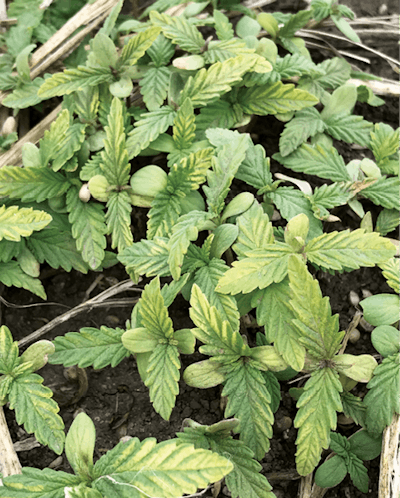
Like this Canadian hemp grower, the conglomeration of multiple hemp farmers is still debating whether it is even worth the fuel, time and cost to harvest this year’s fiber. They still have two years of fiber sitting with no place to go. They are currently searching for outlets.
European hemp farmers, on the other hand, are far more advanced in that they have long-standing relationships with a multitude of manufacturing sources that utilize every bit of the hemp plants they produce. For instance, the leftover fiber “hemp flax” product is purchased and utilized in the manufacturing and constructing of Bentley car seats. Therefore, I’m confident there is an outlet for North American farmers’ fiber somewhere as well. Perhaps there is a manufacturer out there wishing to utilize an alternative source such as hemp fiber, having no inkling that tonnes of it are literally sitting in a field waiting for him.
As the day progressed, I considered the economic value of the crop’s diversified products and their respective costs of production, focusing on products that sell for less than their production costs (or don’t sell at all). I thought of essential questions to ask, such as whether it would be more profitable to target and harvest for essential oil production at the cost of seed maturation? Or is it more profitable to target the mature seed in lieu of the essential oils? Simple math and economics dictate which you should target as a farmer.
While keeping in mind the cost of production, I can only surmise that there are many uses for the raw fiber left in the field, stalks and bales of stalks-even if only utilized for oil-absorbing booms for oil collection off water surfaces, or for plywood, bricks and masonry. Better yet, what about hemp fiber-based media, i.e., grow cubes and blocks? To utilize hemp as a medium or component of medium would surely be an environmentally friendly approach to cannabis production.
I truly hope manufacturing begins to embrace the passionate hemp farmers, such as the individuals I had the pleasure to meet, because that is what is required for the hemp industry to progress. There are now very passionate hemp farmers producing hemp in a multitude of forms, and they need to sell their product to be able to continue to innovate, pay the bills and survive like any other farmer.









